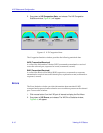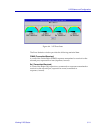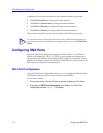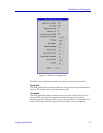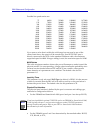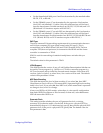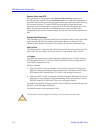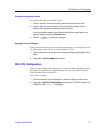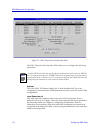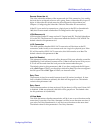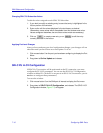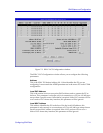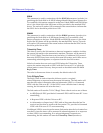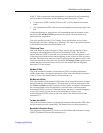
SNA Status and Configuration
7-6 Configuring SNA Ports
Receive Clock from DTE
This parameter is relevant only if the Physical Port Interface (see above) is
something other than RS-232 and Generate Clock is set to Yes. If this parameter is
set to Yes, it allows the clock (timing) signal to be looped back from the DTE using
the Terminal Timing (TT) signal, which can be helpful on high-speed lines.
Generally, if the local interface is a physical DCE and the line speed is above 256
Kbps, this parameter should be set to Yes; however, make sure the DTE is
conÞgured to provide the terminal timing. The default value for this parameter is
No.
Disable Rqst Disconnect
This parameter is only relevant if the PAD type is HPAD. If this value is set to Yes,
it prevents the HPAD from sending a Disconnect Request to the host if the
HPAD-TPAD connection is broken. The default value for this parameter is No.
Idle Fill Char
This Þeld speciÞes a character that will be inserted into the stream when the SNA
link is idle. The two choices are hex-ff and hex-7e; the default value is hex-ff.
L1 Duplex
This Þeld determines level-1 signal operation on RS-232 ports. If Full is selected,
RTS (Request to Send), CTS, (Clear to Send) and DCD are always high (and are
raised by the appropriate side.
If Half is selected:
¥ When the DTE is ready to transmit, it asserts RTS, waits for CTS to become
high, then starts transmitting. When transmission is Þnished, the DTE drops
RTS (and the DCE should drop CTS). DCD is low during this period.
¥ When the DCE is ready to transmit, it checks to see that RTS and CTS are not
high, then it raises DCD and starts transmitting. When transmission is done,
the DCE drops DCD. RTS and CTS are low during this period
For both Full and Half L1-Duplex, the DTE raises DTR (Data Terminal Ready) and
the DCE raises DSR (Data Set Ready).
The default value for this parameter is Full.
!
CAUTION
This parameter must be conÞgured correctly, or the PU will not become active.



